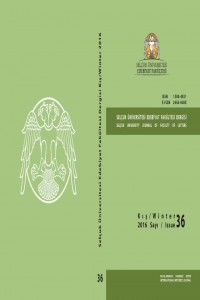Abstract
This paper is the translation of James Smith’
article named “Karagöz and Hacivat: Projections of Subversion and Conformance”
published in Asian Theatre Journal in 2004. Smith, after expressing
history of theatre representations in Islamic world shortly, leads up to shadow
puppetry known as karagöz in Turks, karagiozis in Greek. After giving brief
introductory information about these plays, he gives examples of “food, sex,
violence” in karagöz plays, which are the elements told as actual in nearly all
carnivals according to Peter Burke in his book Popular Culture in Early
Modern Europe. Subsequently, he analyzes shadow puppetry within the frame
of Mikhail Bakhtin’s religious amusement theory. Peculiarly, he surmises that
there is a serious similarity between the scene “enthronement of a fool and in
the end of the carnival the fake king’s dethronement” in the aforementioned
theory and “situation of Karagöz, who is brought to an important position by
Hacivat and then try to beat surrounding people, and in the end all of his
power taken from him”. In the final phase, Smith deals with the role of shadow
puppetry to re-form self-identity of disadvantaged groups in the society and
exemplify the issue over Turk and Greek societies. This paper is significant in
terms of both Western amusement theories’ implementation on karagöz and
karagiozis plays, and how these plays play role in forming a
self-identification process.
References
- AND, Metin (1975). Karagöz (Turkish Shadow Theatre). Ankara: Dost Yay.
- BAKHTIN, Mikhail (1998). “Carnival and the Carnivalesque”. In John Storey. ed., Cultural Theory and Popular Culture: A Reader. Athens: University of Georgia Press.
- BURKE, Peter (1994). Popular Culture in Early Modern Europe. rev. ed. Hants: Scolar Press.
- Kur’an (1997). Translated by N. J. Dawood. London: Penguin Press.
- MARTINOVICH, Nicholas (1933). The Turkish Theatre. New York: Theatre Arts.
- MYRSIADES, Linda S. - MYRSIADES, Kostas (1988). The Karagoizis Heroic Performance in Greek Shadow Theater. Hanover: New England University Press.
- MYRSIADES, Linda S. - MYRSIADES, Kostas (1992). Karagiozis: Culture & Comedy in Greek Puppet Theater. Lexington: University of Kentucky Press.
- MYRSIADES, Linda S. - MYRSIADES, Kostas (1999). Karagoizis: Three Classic Plays. New York: Pella Press.
- TIETZE, Andreas (1977). The Turkish Shadow Theater and the Puppet Collection of the L. A. Meyer Memorial Foundation. Berlin: Gebr. Mann Verlag.
- Turkish Shadow Theater and Karagoz (2000). Turkish Daily News. http://www.turkishdailynews.com/past_probe/12_10_00/leisure.htm#12 [29.12.2003].
Abstract
Bu yazı, James Smith’in Asian Theatre Journal’da 2004 yılında
yayımladığı “Karagöz and Hacivat: Projections of Subversion and Conformance”
adlı makalesinin tercümesidir. Smith, İslam dünyasında tiyatro temsillerinin
tarihini kısaca anlattıktan sonra, sözü Türklerde karagöz, Yunanlarda
karagiozis adıyla bilinen gölge oyunlarına
getirir. Bu oyunlara dair kısa tanıtıcı bilgiler verdikten sonra, Peter
Burke’ün Popular Culture in Early Modern Europe (Erken Modern Avrupa’da
Popüler Kültür) adlı eserinde hemen her karnavalda görüldüğünü söylediği
“yemek, cinsellik ve şiddet” unsurlarına karagöz oyunlarından örnekler verir.
Akabinde, gölge oyununu Mikhail Bakhtin’in dinsel eğlence teorisi çerçevesinde
inceler. Bilhassa, sözü edilen teoride yer alan “bir maskaraya taç giydirilip
kral yapılması ve karnavalın sonunda sahte kralın tahttan indirilmesi hadisesi”
ile “Hacivat tarafından önemli bir mevkie getirildikten sonra çevresindekileri
alt etmeye çalışan ve sonunda bütün gücü elinden alınan Karagöz’ün durumu”
arasında ciddi bir benzerlik olduğu kanısına varır. Son aşamada, gölge
oyununun, ezilen toplum kitlesinin özkimliğini yeniden oluşturmadaki rolüne
değinerek, meseleyi Türk ve Yunan halkları üzerinden örneklendirir. Bu yazı,
hem Batılı eğlence kuramlarının karagöz ve karagiozis oyunlarına uygulanmış
olması, hem de bu oyunların yeni bir özkimlik oluşturmada nasıl bir görev
üstlendiğini göstermesi bakımından önemlidir.
References
- AND, Metin (1975). Karagöz (Turkish Shadow Theatre). Ankara: Dost Yay.
- BAKHTIN, Mikhail (1998). “Carnival and the Carnivalesque”. In John Storey. ed., Cultural Theory and Popular Culture: A Reader. Athens: University of Georgia Press.
- BURKE, Peter (1994). Popular Culture in Early Modern Europe. rev. ed. Hants: Scolar Press.
- Kur’an (1997). Translated by N. J. Dawood. London: Penguin Press.
- MARTINOVICH, Nicholas (1933). The Turkish Theatre. New York: Theatre Arts.
- MYRSIADES, Linda S. - MYRSIADES, Kostas (1988). The Karagoizis Heroic Performance in Greek Shadow Theater. Hanover: New England University Press.
- MYRSIADES, Linda S. - MYRSIADES, Kostas (1992). Karagiozis: Culture & Comedy in Greek Puppet Theater. Lexington: University of Kentucky Press.
- MYRSIADES, Linda S. - MYRSIADES, Kostas (1999). Karagoizis: Three Classic Plays. New York: Pella Press.
- TIETZE, Andreas (1977). The Turkish Shadow Theater and the Puppet Collection of the L. A. Meyer Memorial Foundation. Berlin: Gebr. Mann Verlag.
- Turkish Shadow Theater and Karagoz (2000). Turkish Daily News. http://www.turkishdailynews.com/past_probe/12_10_00/leisure.htm#12 [29.12.2003].
Details
| Journal Section | Çeviri/Translation |
|---|---|
| Authors | |
| Publication Date | December 22, 2016 |
| Submission Date | August 26, 2016 |
| Published in Issue | Year 2016 Issue: 36 |
Cited By
Seçme Hikâyeler Hacivat ve Karagöz eserinin İngilizce çevirisi üzerine bir çalışma
RumeliDE Dil ve Edebiyat Araştırmaları Dergisi
Burcu YAMAN
https://doi.org/10.29000/rumelide.984847
Selcuk University Journal of Faculty of Letters will start accepting articles for 2025 issues on Dergipark as of September 15, 2024.

